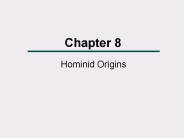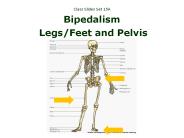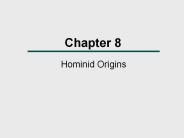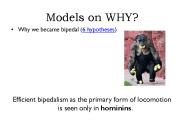Bipedalism PowerPoint PPT Presentations
All Time
Recommended
Backpedaling in human evolution Adaptive values of bipedalism in reverse J.K. McKee, A. Kolatorowicz, L. Reitsema, A. Ruth, S. Schlecht, O. Ulvi, T. Weston
| PowerPoint PPT presentation | free to download
... hip joint and muscles to stabilize pelvis. Changes in the femur: Angles inward to allow for support under torso. Groove in femur keeps knee cap from sliding off ...
| PowerPoint PPT presentation | free to view
'Radiator Theory' Efficient Locomotion. Disadvantages of Bipedalism? ... For Monday, Zimmer, Chapter 6. Title for Ch. 6 in the syllabus is wrong but page ...
| PowerPoint PPT presentation | free to view
... split between human and chimpanzee ancestors. Millions of years ago ... KW hypothesis: Chimpanzee/human bipedalism ... in a forested, not savannah habitat ...
| PowerPoint PPT presentation | free to download
... the first bipedal hominins would have been good climbers (as are chimpanzees) ... woodland habitats where it would have been impossible to see predators ...
| PowerPoint PPT presentation | free to view
& BIOMECHANICS LAB Walking the walk: ... and scoliosis increase in size of babies head at birth Women s average pelvic size has not been able to keep up !!!!!
| PowerPoint PPT presentation | free to download
'to see the familiar as unfamiliar, and the unfamiliar as familiar' Francis Bacon ' ... Titomanlio et al 2005 Neurology, 64, E21 ...
| PowerPoint PPT presentation | free to download
Models on WHY? Why we became bipedal (6 hypotheses) Efficient bipedalism as the primary form of locomotion is seen only in hominins. Origins of all these bipedalism ...
| PowerPoint PPT presentation | free to download
HUMAN EVOLUTION: GENUS AUSTRALOPITHECUS & PARANTHROPUS Map of Hominid Evolution Why did bipedalism become the primary adaptation of hominids? 1.
| PowerPoint PPT presentation | free to download
Habitat variability and bipedalism (Potts) Reproduction and bipedalism (Lovejoy) ... A comparison of human and chimpanzee pelves. Dentition ...
| PowerPoint PPT presentation | free to view
... chimpanzees, and humans ... Characteristics Revised Classification of Hominoids The Bipedal Adaptation Efficient bipedalism as the primary form of locomotion ...
| PowerPoint PPT presentation | free to download
Archaeopteryx has very similar skeletal structure to some smaller theropods. Three fingered forelimb. Reversed toe. Bipedalism. Ancestry: Thecodont ...
| PowerPoint PPT presentation | free to view
Humans are hominids, belonging to the taxonomic family Hominidae. Bipedalism, walking on two legs, is ... dermatoglyphics. genetics. anthropometrics. Answer: d ...
| PowerPoint PPT presentation | free to download
size between gibbon and chimpanzee. principally arboreal, not exclusively. preference for upright posture. some bipedalism, in trees & ground ...
| PowerPoint PPT presentation | free to view
Chapter 6 The First Bipeds Chapter Outline What Is the anatomy of bipedalism and how is it preserved in the fossil record? Who were the Australopithecines and what ...
| PowerPoint PPT presentation | free to download
TT. TT. TT. tt. Tt. Tt. Tt. Tt. The Wrap-Up. Evolution of life on Earth. Great Rift Valley. Arboreal & savanna environments. Bipedalism ...
| PowerPoint PPT presentation | free to view
Anthropology 1. Physical Anthropology. David Midyette. Where . . . Australopithecines . . . Taung Child. Lucy. Laetoli . . . Bipedalism . . . Fossil In Situ ...
| PowerPoint PPT presentation | free to view
H. erectus: Skull. Reconstruction of one of the H. erectus fossils from ... Larger skulls select for neotony, because of the constraints bipedalism puts on ...
| PowerPoint PPT presentation | free to view
Chapter 20: Human Evolution - How do humans differ from closely related species? Hominids Upright walking primates (includes monkeys, apes, & humans) Earliest ...
| PowerPoint PPT presentation | free to view
The Functional Anatomy
| PowerPoint PPT presentation | free to view
Who were the Australopithecines and what were they like? ... brain suggest a intelligence similar to a modern bonobo, chimpanzee, or gorilla. ...
| PowerPoint PPT presentation | free to view
Understanding Physical Anthropology and Archaeology, 8th ed., p. 217 Possible Factors Influencing the Initial Evolution of Bipedal Locomotion in Hominids.
| PowerPoint PPT presentation | free to download
Human Evolution ...
| PowerPoint PPT presentation | free to view
Title: Chapter 8 Hominid Origins Author: stacy Last modified by: Foothill College Created Date: 11/6/2000 11:38:04 PM Document presentation format
| PowerPoint PPT presentation | free to download
Chimpanzee versus ... chimps who live in more Savannah-like habitats (i.e. tool use) ... Given how skillful the chimpanzees studied by Boesch & Boesch ...
| PowerPoint PPT presentation | free to view
Arm-hanging anatomy persists long after the onset of ... Large muscle attachment areas. Paranthropus robustus. DNH 7, 'Eurydice', Paranthropus robustus. ...
| PowerPoint PPT presentation | free to view
This is Jeopardy Human Evolution * * Category No. 1 Category No. 2 Category No. 3 Category No. 4 Category No. 5 100 100 100 100 100 200 200 200 200 200 300 300 300 ...
| PowerPoint PPT presentation | free to download
Title: PowerPoint Presentation Author: Dennis Last modified by: Debbie Created Date: 7/16/2002 6:58:30 AM Document presentation format: On-screen Show
| PowerPoint PPT presentation | free to download
General Features and Major Evolutionary Trends of Apes ... orangutans. bonobos. chimps. gorillas. humans. Campbell and Loy, Humankind Emerging, 8th ed, p. 138f ...
| PowerPoint PPT presentation | free to download
Chapter 11 Hominid Origins in Africa Chapter Outline The Bipedal Adaptation Early Hominids from Africa (Pre-Australopithecus Finds) Australopithecus/Paranthropus from ...
| PowerPoint PPT presentation | free to download
Bones of antelopes, horses, and other animals with cut marks made by ... Signs that hominids scraped & smashed animal bones, like this antelope tibia, 2.5 mya ...
| PowerPoint PPT presentation | free to download
Why was Homo erectus so successful? What happened to Neandertals? ... discovered in the Neander Valley (Tal) near Dusseldorf, 1856 ...
| PowerPoint PPT presentation | free to view
Primates and Human Origins Identify traits that distinguish primates from other mammals. Describe fossil evidence relating humans to primate ancestors.
| PowerPoint PPT presentation | free to view
Chapter 8 Hominid Origins Chapter Outline Early Primate Evolution Miocene Fossil Hominids Definition of Hominid The Bipedal Adaptation Biocultural Evolution: The ...
| PowerPoint PPT presentation | free to download
Primate Evolution Hominid Evolution. The work of Primate ... Mongoose, robins) Some primates (actually at least one-i.e. Panamanian tamarin) have claws ...
| PowerPoint PPT presentation | free to view
Title: No Slide Title Author: Kelly L. Moore Last modified by: Kelly L. Moore Document presentation format: On-screen Show (4:3) Other titles: Arial Times Default ...
| PowerPoint PPT presentation | free to view
Evolution Part 3 Timeline and Human Evolution Jim Whitfield
| PowerPoint PPT presentation | free to view
Each subdivision is associated with a particular group of hominids. Late Australopithecus and early Homo lived during Lower. Homo Erectus spanned most of Middle, ...
| PowerPoint PPT presentation | free to view
Hominin Evolution * * * Pre-dating Australopithecus Hominins discovered in north-central and eastern Africa Bipedal debatable in some species We will focus on the ...
| PowerPoint PPT presentation | free to download
Chapter 9 Paleoanthropology: Reconstructing Early Hominid Behavior and Ecology Chapter Outline Definition of Hominid The Strategy of Paleoanthropology ...
| PowerPoint PPT presentation | free to download
Human Evolution Chapter 17 Primates Order primates includes prosimians, monkeys, apes, and humans Adapted for an arboreal life Human Evolution Humans and apes have a ...
| PowerPoint PPT presentation | free to view
Primate. origin. K-T boundary marked by an asteroid impact. Evidence, ... Primate Origins. Challenge is to minimize speculation on things that do not fossilize. ...
| PowerPoint PPT presentation | free to view
Title: Chapter 17 Author: user Last modified by: Tim Heffernan Created Date: 3/10/2006 2:05:47 AM Document presentation format: On-screen Show Company
| PowerPoint PPT presentation | free to download
Probably developed between 8 and 4 million years ago in Africa, but we are still ... Saggital crest and temporo-nuchal crest across lower back of skull 'Apelike' face ...
| PowerPoint PPT presentation | free to view
limbs can move in various directions - grasping power of hands and feet ... (midway between chimp and gorilla) - 3.5 4 feet high - longer arms than humans ...
| PowerPoint PPT presentation | free to view
... to date materials in the 5-1 mya range Carbon-14 method used to date organic material extending back to 75,000 years Thermoluminescence Uranium series dating ...
| PowerPoint PPT presentation | free to download
Monkeys and apes have opposable thumbs, meaning they can touch the ventral ... a collision between the Indian and Asian tectonic plates about 10 million years ago. ...
| PowerPoint PPT presentation | free to view
Be able to briefly trace the cultural development of: tools, fire, clothing, shelter, art ... discovered in the Neander Valley (Tal) near Dusseldorf, 1856 ...
| PowerPoint PPT presentation | free to view
Chapter 8 Hominid Origins Chapter Outline Definition of Hominid The Bipedal Adaptation Biocultural Evolution: The Human Capacity for Culture Paleoanthropology as a ...
| PowerPoint PPT presentation | free to download
fossil evidence for hominid evolution sc.912.l.15.11
| PowerPoint PPT presentation | free to view
What sort of features characterize Paleolithic cave art, and what was the general purpose of this art for Homo sapiens? Primate and Human Larynxes Reflection ...
| PowerPoint PPT presentation | free to view
Manual dexterity (opposable thumb), large forehead and cerebral cortex, ... high encephalization quotient compared to Great Dane (because we bred it to have ...
| PowerPoint PPT presentation | free to view
Humans feel (more) comfortable interacting with human-shaped robots. The ... Dexter made by Anybots. Constantly adjusts balance using 'inner ear' like humans ...
| PowerPoint PPT presentation | free to view
Key Points. Heritable characteristics increase or decrease an organisms chance of survival. Evolution is the change of the genetic makeup of a population over time
| PowerPoint PPT presentation | free to download
Scholar Thomas Huxley believed Neandertals were no different from modern humans. ... Theorists believe that archaic homo sapiens and Neandertals represent phases in ...
| PowerPoint PPT presentation | free to view
Vertebrates are part of a larger phylum called Chordata which includes ... After the Devonian, the Carboniferous period was 'The age of the amphibians' ...
| PowerPoint PPT presentation | free to download
























































